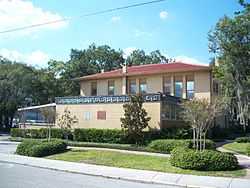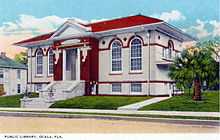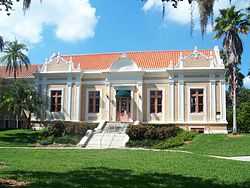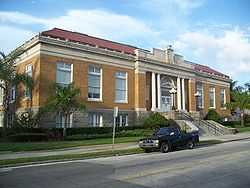List of Carnegie libraries in Florida
The following list of Carnegie libraries in Florida provides detailed information on United States Carnegie libraries in Florida, where 10 public libraries were built from 10 grants (totaling $198,000) awarded by the Carnegie Corporation of New York from 1901 to 1917. In addition, academic libraries were built at 4 institutions (totaling $76,500).
Key
Building still operating as a library
Building standing, but now serving another purpose
Building no longer standing
Building listed on the National Register of Historic Places
Building contributes to a historic district on the National Register of Historic Places
Carnegie libraries
| Library | City or town |
Image | Date granted[1] |
Grant amount[1] |
Location | Notes | |
|---|---|---|---|---|---|---|---|
| 1 | Bartow | Bartow | Mar 18, 1911 | $8,000 | Demolished in 1998 | ||
| 2 | Bradenton | Bradenton |  |
Feb 3, 1917 | $10,000 | ||
| 3 | Clearwater | Clearwater | Mar 16, 1915 | $10,000 | Demolished c.2000 | ||
| 4 | Gainesville | Gainesville | Mar 31, 1916 | $10,000 | Demolished in 1954 | ||
| 5 | Jacksonville | Jacksonville |  |
Feb 13, 1902 | $55,000 | ||
| 6 | Ocala | Ocala |  |
Feb 21, 1907 | $10,000 | Demolished in 1968 | |
| 7 | Palmetto | Palmetto |  |
Jan 14, 1914 | $10,000 | ||
| 8 | St. Petersburg | St. Petersburg |  |
Jul 9, 1913 | $17,500 | ||
| 9 | Tampa | Tampa |  |
Dec 30, 1901 | $50,000 | ||
| 10 | West Tampa | West Tampa |  |
Jan 2, 1913 | $17,500 |
Academic libraries
| Institution | Locality | Image | Year granted |
Grant amount |
Location | Notes | |
|---|---|---|---|---|---|---|---|
| 1 | Fessenden Academy | Martin | Mar 15, 1905 | $6,500 | |||
| 2 | Florida State Normal and Industrial College | Tallahassee | |
Jul 18, 1905 | $10,000 | Now the Southeastern Regional Black Archives Research Center and Museum | |
| 3 | John B. Stetson University | DeLand |  |
Mar 12, 1906 | $40,000 | Now Sampson Hall | |
| 4 | Rollins College | Winter Park | Jun 22, 1905 | $20,000 |
Carnegie Hall Library at Rollins College
One of the Florida libraries funded by Andrew Carnegie was on the campus of Rollins College in Winter Park. According to Cohen (2006), Carnegie’s “donation of 108 libraries to colleges in the first two decades of the twentieth century assisted 10 percent of the institutions of higher learning in the United States. Carnegie had a preference for colleges and universities that served African-American students, which Rollins College president William Fremont Blackman noted the school did in a letter to Carnegie appealing for a library in 1904:[2]
The fact that it is the only college in the country, North or South, in which the grandchildren of abolitionists and confederate soldiers, in about equal numbers, sit together in the same class-room and play together on the same athletic field, and learn thus to understand, respect and love one another;
Blackman’s request consisted of $35,000 in total: “$20,000 for a fireproof building, $3,000 for books, and $12,000 as an endowment for the continued purchase of books” (Cohen). Blackman received a response from Carnegie’s secretary James Bertram that noted the request was too general for consideration, and that Carnegie would need a profile of the university before consideration. Little progress was made for over a year, when Blackman again wrote to Carnegie, noting the university’s need for a library. Trustees and friends of the university wrote to Carnegie on Blackman’s behalf, including W.W. Cummer, a trustee from Jacksonville who served on the board of the city’s new Carnegie Library. A letter dated 22 June 1905 and written from Carnegie’s home in Scotland brought the welcome news of the offer of a library. Carnegie offered $20,000 for the construction of a library provided that the same amount would be raised for the library’s upkeep. While grateful for Carnegie’s proposal, Blackman was uneasy with its terms because the amount of funding required to match Carnegie’s offer would put a strain on those who had donated to start the college’s endowment fund ($200,000) as well as paid a debt ($30,000). In correspondence to Bertram dated July 11, 1905 Blackman wrote (according to Cohen):
Our college is in the poorest of States, remote from all centers of wealth and population, and our friends have strained themselves to the uttermost, in the effort to raise $230,000 in two years. I am by no means sure that we can meet Mr. Carnegie’s conditions.
In a January 1906 letter Blackman wrote to Carnegie expressing concern about meeting the conditions for the gift, noting that the college had a large debt that took “considerable self-sacrifice on the part of our friends.” That summer, another Florida college, Stetson University, was awarded $40,000 for a library from Carnegie. Upon learning this Blackman again wrote to Carnegie, seeking to amend the original terms of the agreement to match the amount that Stetson was awarded. He was turned down, but a year later was able to notify Carnegie that the school’s trustees had been able to match the $20,000 necessary for the gift to be awarded. Bertram wrote to Blackman to inform him that Carnegie had “authorized his Cashier…to arrange payments on Library Building, as work progresses, to the extent of Twenty Thousand Dollars.” The library, to be named Carnegie Hall, was dedicated on February 18, 1909.
The building had over 8,000 square feet of space, and was the school’s first dedicated library building. It served as so from 1909 until 1951. In addition to its function as a library, Carnegie Hall also served as the school’s post office. Since the library was moved from Carnegie to the newly built Mills Memorial Library, it has also housed a bookstore, admissions office, faculty offices, and human resources.[3]
Notes
- ↑ 1.0 1.1 At various times, Bobinski and Jones disagree on these numbers. In these cases, Jones' numbers have been used due to both a more recent publication date and a more detailed gazetteer of branch libraries, which are often where the discrepancies occur.
- ↑ Cohen, D.K. (2000). Andrew Carnegie and Academic Library Philanthropy: The Case of Rollins College, Winter Park, Florida. Libraries & Culture, 35(3), 389-408. Retrieved from http://www.jstor.org.ezproxy.lib.usf.edu/stable/25548838
- ↑ Rollins Olin Library. (2012). History of the Rollins Library-Library Buildings. Retrieved from http://www.rollins.edu/library/about/history2.html
References
- Anderson, Florence (1963). Carnegie Corporation Library Program 1911–1961. New York: Carnegie Corporation. OCLC 1282382.
- Bobinski, George S. (1969). Carnegie Libraries: Their History and Impact on American Public Library Development. Chicago: American Library Association. ISBN 0-8389-0022-4.
- Jones, Theodore (1997). Carnegie Libraries Across America. New York: John Wiley & Sons. ISBN 0-471-14422-3.
- Miller, Durand R. (1943). Carnegie Grants for Library Buildings, 1890–1917. New York: Carnegie Corporation of New York. OCLC 2603611.
Note: The above references, while all authoritative, are not entirely mutually consistent. Some details of this list may have been drawn from one of the references (usually Jones) without support from the others. Reader discretion is advised.